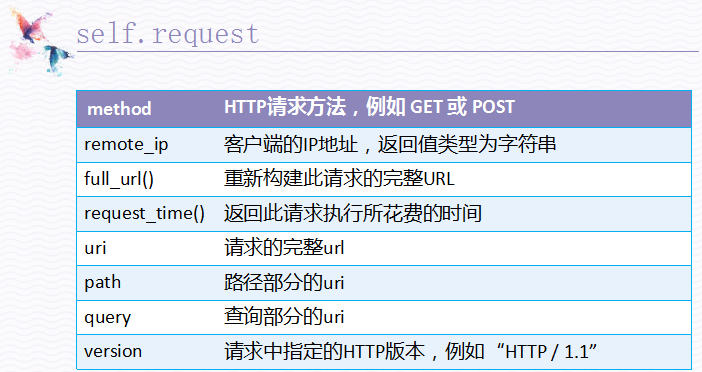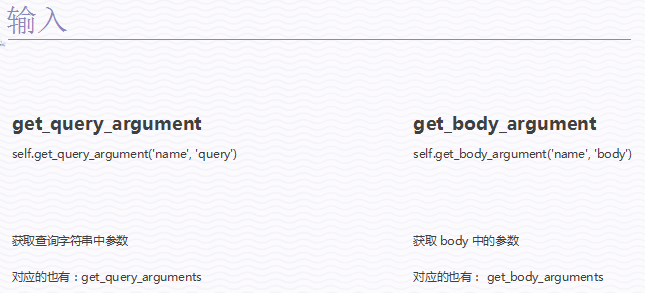输入输出:
class MainHandler(RequestHandler): def get(self): self.write('hello world') self.write(123) #这一行会报错
报错信息如下:
TypeError: write() only accepts bytes, unicode, and dict objects
输入输出:
输出:
write能写的几种格式 bytes, unicode, and dict objects
bytes
字符串
字典
json
flush
渲染模板render 添加模板位置templates
路由跳转redirect
结束:finish
class MainHandler(RequestHandler): def get(self): self.write('hello world') self.write('<br/>') self.write(b'hello world') #bytes self.write('<br/>') # self.write(123) #报错 self.flush() #强制吧缓冲区的内容刷新到浏览器 di = { 'name': 'shiwei', 'age': 23 } self.write(di) # dictory #当write方法向浏览器输出字典的时候,其他所有的格式都不被解析, #当浏览器输出字典时候,其他的全部被当成json字符串的一部分输出 li = ['taka',52] # self.write(li) #列表也不能写入 self.write(str(li)) #将列表转换成字符串 li = json.dumps(li) #转换成json的字符串 self.write(li) self.finish() self.write('1111') #调用finish之后,不会输出到浏览器上,代码依然会被执行性 # 报错raise RuntimeError("Cannot write() after finish()") #字节格式,字符串,字典 #b'hello' 字节 #'hello' #{'name':'shiwei'} class TemHandler(RequestHandler): def get(self): self.render('in_out.html') #将页面写到一个文件里面,当我们访问这个路由的时候读取文件 class RedHandler(RequestHandler): def get(self): time.sleep(5) self.redirect('/tem') application = tornado.web.Application( handlers=[ (r'/', MainHandler), (r'/tem', TemHandler), (r'/red', RedHandler), ], template_path = 'templates', #指定静态模板的文件夹 debug=True #方便调试 )
获取请求信息
class ReqHandler(RequestHandler): def get(self): print(self.request) self.write(self.request.remote_ip) application = tornado.web.Application( handlers=[ (r'/req', ReqHandler), ], template_path = 'templates', #指定静态模板的文件夹 debug=True #方便调试 )
self.request中包含所有的请求信息:

可以使用的方法:

输入:
get_argument只能获取输入的最后一个参数,调用了get_arguments,并且取列表的最后一个元素,获取 URL 和 Body中数据
get_arguments 获取输入的列表,复选框的时候使用
-- 获取URL数据
get_argument
可以获取URL(查询字符串)中的参数
-- 获取body数据
get_argument
可以获取body(请求体)中的数据
get_argument返回的值始终是unicode

02-input_output.py
class GetHandler(RequestHandler): def get(self): self.render('in_out.html') def post(self): # name = self.get_argument('name','') name = self.get_body_argument('name','') self.write(name) self.write('<br/>') password = self.get_argument('password','') self.write(password) application = tornado.web.Application( handlers=[ (r'/get', GetHandler), ],
in_out.html代码:
<!DOCTYPE html> <html lang="en"> <head> <meta charset="UTF-8"> <title>tornado</title> </head> <body> <form method="post" action="/get"> <p>用户名<input type="text" name="name"></p> <p>密码<input type="password" name="password"></p> <input type="submit"> </form> </body> </html>
URL传参
1.REST风格查询
class SubHandler(RequestHandler): def get(self,name,age): self.write('name:%s <br/> age:%s'%(name,age)) application = tornado.web.Application( handlers=[ (r'/sub/(?P<name>.+)/(?P<age>[0-9]+)', SubHandler), ],
请求结果如下:

2.字符串风格,?key=value
class SubHandler(RequestHandler): def get(self): name = self.get_argument('name','')
self.write(name)
application = tornado.web.Application( handlers=[ (r'/sub/', SubHandler), ],
请求结果如下:
